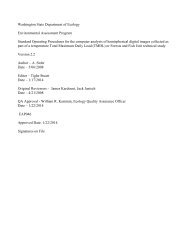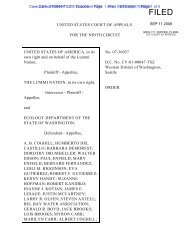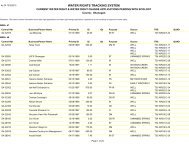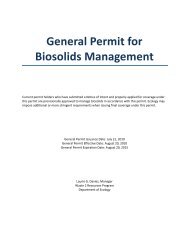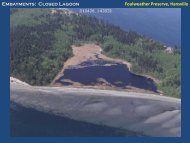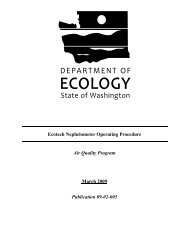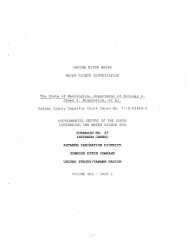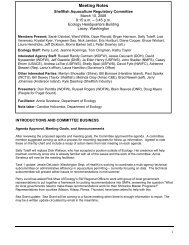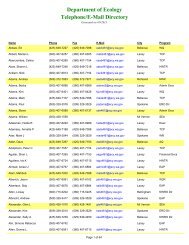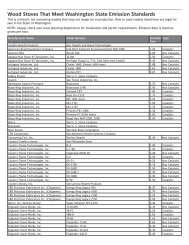WRIA 62 WMP 032305 - Washington State Department of Ecology
WRIA 62 WMP 032305 - Washington State Department of Ecology
WRIA 62 WMP 032305 - Washington State Department of Ecology
You also want an ePaper? Increase the reach of your titles
YUMPU automatically turns print PDFs into web optimized ePapers that Google loves.
March, 2005 -47- 023-1289-003.3040<br />
1) VARQ results in slightly lower flows in the Pend Oreille River below Albeni Falls Dam during<br />
March and April when flooding at Cusick can be a problem; and, 2) flows in the Pend Oreille River<br />
below Albeni Falls Dam are slightly higher in June under VARQ but the frequency <strong>of</strong> exceeding the<br />
flood warning threshold <strong>of</strong> 100,000 is essentially the same for VARQ as the Standard flood control<br />
plan. This study can be viewed on the internet at http://137.77.133.1/pn/programs/VARQ/links.html.<br />
Implementation <strong>of</strong> VARQ does not generally change Hungry Horse reservoir levels unless water<br />
volume is between 80-100% <strong>of</strong> a typical water year (otherwise VARQ elevations are consistent with<br />
Standard Flood Control elevations). In terms <strong>of</strong> flooding in <strong>WRIA</strong> <strong>62</strong>, the biggest concern is that<br />
Hungry Horse reservoir is held high in the winter in order to achieve flood control levels by April 10.<br />
If there is unusually high precipitation in March, it is likely that Hungry Horse would be required to<br />
spill water (to maintain flood control levels) at the same time, therefore exacerbating the impact <strong>of</strong> the<br />
local spring melt and run<strong>of</strong>f occurring in <strong>WRIA</strong> <strong>62</strong>. The combination <strong>of</strong> Hungry Horse spilling and<br />
high local run<strong>of</strong>f increases the potential for flooding to occur in the Calispell Valley and other low<br />
lying areas along the Pend Oreille River.<br />
4.1.4.1.1.2 Albeni Falls Dam<br />
Albeni Falls Dam is a multiple purpose water resource project owned by the U.S. Government and<br />
regulated under authorization from Congress by the Army Corps <strong>of</strong> Engineers (ACOE) Northwestern<br />
Division and Seattle District. Any change in operations that cause river flows and elevations outside<br />
authorized limits (see Table 4-3 and the bullets below) would require authorization from Congress.<br />
The project is located in Idaho on the Pend Oreille River at river mile 90.1, about 2.5 miles upstream<br />
and east <strong>of</strong> the City <strong>of</strong> Newport and the upstream boundary <strong>of</strong> <strong>WRIA</strong> <strong>62</strong>. The project is operated to<br />
regulate Lake Pend Oreille considering upstream flood control (primarily for the City <strong>of</strong> Sandpoint)<br />
and also for recreation, fish and wildlife conservation and power generation. Flood control benefits<br />
are realized upstream <strong>of</strong> the dam by lowering the elevation <strong>of</strong> Lake Pend Oreille during peak floods<br />
(between 80,000 and 220,000 cfs). The ACOE is mandated to operate Albeni Falls Dam in a manner<br />
that does not make flooding any worse downstream than it would be under natural conditions.<br />
The inflows to Pend Oreille Lake are largely determined by the outflow <strong>of</strong> Avista’s Cabinet Gorge<br />
Dam upstream <strong>of</strong> Albeni Falls. The outflows from Albeni Falls Dam are managed to maintain lake<br />
elevations. Project operating limits (resulting in useable storage <strong>of</strong> about 1,155,100 AF) range from a<br />
minimum authorized lake elevation <strong>of</strong> 2,049.7 ft amsl to normal full pool at 2,0<strong>62</strong>.5 ft amsl.<br />
However there is no scheduled or anticipated plan to draft the lake below the minimum normal pool<br />
elevation <strong>of</strong> 2,051 ft amsl (resulting in actual useable storage <strong>of</strong> 1,042,700 AF). Typically summer<br />
pool is held at 20<strong>62</strong>.5 feet amsl to just after Labor Day and winter pool is between 2051 and 2055 feet<br />
depending on fish needs. Spring fill rate is generally determined by inflows and the natural<br />
constriction at Dover.<br />
Table 4-3 summarizes the Lake Pend Oreille Elevation Rule Curves. In addition to the rule curves,<br />
the following elevation change and discharge limits are imposed on operations at Albeni Falls Dam:<br />
<strong>WRIA</strong> <strong>62</strong> <strong>WMP</strong> <strong>032305</strong><br />
• Maximum Lake Pend Oreille elevation change <strong>of</strong> 0.4 ft per day above elevations <strong>of</strong><br />
2,058 ft amsl.<br />
• Maximum Lake Pend Oreille elevation change <strong>of</strong> 0.5 ft per day below elevations <strong>of</strong><br />
2,058 ft amsl.<br />
• Minimum instantaneous discharge <strong>of</strong> 4,000 cfs.



